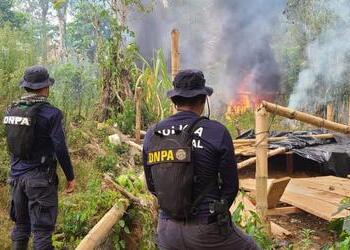Nearly half of northern Central America has the ideal agricultural conditions for growing coca, the raw material for cocaine, according to a new study that warns of the potential spread of the illicit crop across the region.
The research paper, published in the journal Environmental Research Letters, examined the soil quality, climate, and topography of Central America and determined that at least 47% of the region’s north –encompassing Honduras, Guatemala, and Belize– had favorable characteristics for coca cultivation. However, the authors warned that the crop could spread further depending on social, economic, and political factors in the region.
The study gathered publicly available information on coca eradication efforts by authorities in Central America and then analyzed land usage of coca plantations and land coverage surrounding the coca fields. This data was fed to machine-learning land suitability models, commonly used to assess other crops, like palm, and the results were analyzed by the paper’s authors.
Why Coca Could Put Down Roots in Central America
Traditionally, the coca plant has been grown in South America, with Colombia, Peru, and Bolivia serving as the world’s three primary producers. However, the investigators’ models identified several factors that made some Central American regions apt for coca cultivation, when compared to these major producers.
SEE ALSO: Coca in Honduras: Cultivating and Consuming Fear
First, coca production in Central America is distributed over a similar elevation range to Colombia’s coca plantations, which served as the main comparison area in the study. The findings even revealed that some areas of Colombia have recorded coca cultivation in areas at higher elevations than those registered in Central America.
Second, the climate and rainfall variables between both regions also overlapped. Annual precipitation and minimum temperature levels in parts of Central America coincided with coca-growing locations in Perú and Bolivia.
“We wanted to know if this illegal crop could be grown in an area where we don’t think it has been grown until recently. And it turns out it is great for growing coca. It’s ideal,” said Kendra McSweeney, corresponding author of the study and professor of geography at Ohio State University, in a press release.
How the Drug War Spurred Coca Growth in Central America
Eradication and anti-narcotics efforts in Colombia, Perú, and Bolivia have led criminal groups to explore other areas for coca cultivation. Experimental crops have been popping up in Honduras, Guatemala, Mexico, and Costa Rica since at least 2017, and they appear to have taken hold. Crops have also been reported in Venezuela, along the border with Colombia in recent years.
The study analyzed reports of coca eradication primarily in Honduras and Guatemala. In the first case, most incidents occurred in the departments of Colón (28 sites), Olancho (7), and Yoro (1). In Guatemala, researchers found coca eradication reports in Izabal (6), Petén (5), Alta Verapaz (5) and Zacapa (1).
These countries are fertile territory for coca plantations and cocaine processing, thanks to well documented relationships between corrupt elites and drug traffickers, alongside infamously ineffective justice systems. While the current coca plantations appear to be experimental and small-scale, conditions seem right for the crop’s expansion.
Challenges for Central American Governments
The study emphasized that social, economic, and political factors are key to preventing coca expansion in Central America, with significant implications for public policy.
Central America could face the same challenges seen in South America, where eradication measures led to a balloon effect, pushing coca crops to new areas.
SEE ALSO: Coca May Have Permanently Taken Root in Central America
“The geography of coca expansion is very likely to be shaped by the degree to which Guatemala, Honduras, and Belizean governments pursue crop eradication and cocaine interdiction as their primary approaches to cocaine markets, rather than alternatives,” the study suggests.
Furthermore, while increased coca cultivation in Central America is unlikely to rival the maximum coca production in South America, it could still break the region’s monopoly on the crop by offering traffickers a source of cocaine closer to the consumer markets. Traffickers could take advantage of poor rural communities that could willingly switch to coca cultivation if it proves profitable, much like the shift seen with opium poppy and marijuana crops. This, combined with the emergence of new coca varieties in Colombia, selected to be more resistant and yield higher cocaine production, could increase the risk of greater coca cultivation in Central America.
Featured image: Two Honduran National Civil Police officers participate in the incineration of a coca leaf plantation detected in a nature reserve in the municipality of Patuca, Olancho department, on May 15, 2023. Credit: National Civil Police of Honduras
Source link : http://www.bing.com/news/apiclick.aspx?ref=FexRss&aid=&tid=66f395b390824d9b89f67a90aff68fec&url=https%3A%2F%2Finsightcrime.org%2Fnews%2Fcentral-america-primed-coca-expansion-study%2F&c=9651267035104272063&mkt=en-us
Author :
Publish date : 2024-09-20 04:37:00
Copyright for syndicated content belongs to the linked Source.
